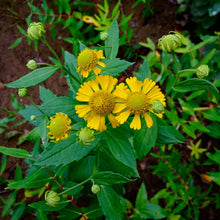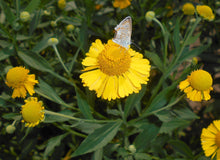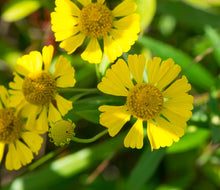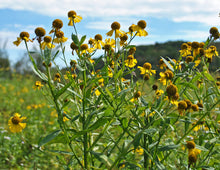
Helenium autumnale
Common sneezeweed is a tall perennial wildflower that will adorn the moist to seasonally wet areas or your garden with cheerful sunflower-like late season blooms. The plants are fast growing, producing oblong or lance-shaped leaves along stiff, upright stems that can shoot four feet high in one season. Its floral display is truly prolific, with one mature plant producing up to 100 blooms! The abundant show attracts bees, butterflies and other insect pollinators and provides a critical source of late season nectar.
- Plant type/canopy layer: deciduous, perennial, herbaceous plant
- Size at maturity: 24”-48” tall, 24” wide
- Light requirements: full sun, part sun/part shade
- Moisture requirements: moist to seasonally wet soil
- Bloom time: August - October
- Growth rate/ease: fast growing, easy to grow
- Wildlife support: flowers attract and provide nectar to adult butterflies, bees and other insect pollinators; overall plant is a host plant and larval food source for native moths and butterflies
- Native habitat/range: grows in vernal areas, wet meadows, and moist forest edges, at low elevations, across much of the United States and Canada. In Oregon and Washington, it is most common in proximity to the Columbia River corridor, as well in the Klamath basin. This plant is not listed in the Portland Plant List, but it will be added in the next edition as it has many documented local occurrences.
- Special features & uses: deer resistant; great in seasonal bouquets; landscape uses include raingardens, wet meadows, and moist pollinator gardens.
Gardening with Common Sneezeweed: This chipper plant is a beautiful, unique addition to moist or seasonally wet areas of the garden, like a sunny raingarden. It requires partial to full sun and will get leggy if it's getting less than six hours of sun per day. It can still thrive with afternoon or evening shade, especially if planted in less-moist areas. It adapts to a wide range of soil types (sandy, loamy, clay) as long as some moisture is present. It will grow nicely in low-lying meadows or along the edges of damp woodlands. Deadhead spent flowers to encourage subsequent blooms.
Sneezeweed also has, embedded in its name, the undeserved reputation of causing allergies. However, the flowers of this plant are actually pollinated by insects, with sticky, heavy pollen that attaches to their legs and underbelly. It does not easily become windborne or get readily inhaled. It is believed to be called sneezeweed because some traditional cultures pulverized the flowers to make a snuff to treat head colds, which induced sneezing. Please note - it is not uncommon for plants with potent medicinal qualities to also be toxic. In this case, sneezeweed is moderately toxic if consumed in large quantities. So don’t make yourself an extra large salad of it for dinner! Medicinal preparations were and should always be done by or in direct consultation with expert herbalists.
Photo Credit 1: - "Helenium autumnale - Sneezeweed" by FritzFlohrReynolds is licensed under CC BY-SA 2.0.
Photo Credit 2: "Helenium autumnale 2015-07-25 5063" by Salicyna is licensed under CC BY-SA 4.0.
Photo Credit 3: "Common Sneezeweed (Helenium autumnale)" by wackybadger is licensed under CC BY-SA 2.0.
Photo Credit 4: "Sneezeweed (Helenium autumnale)" by aarongunnar is licensed under CC BY-SA 2.0.







